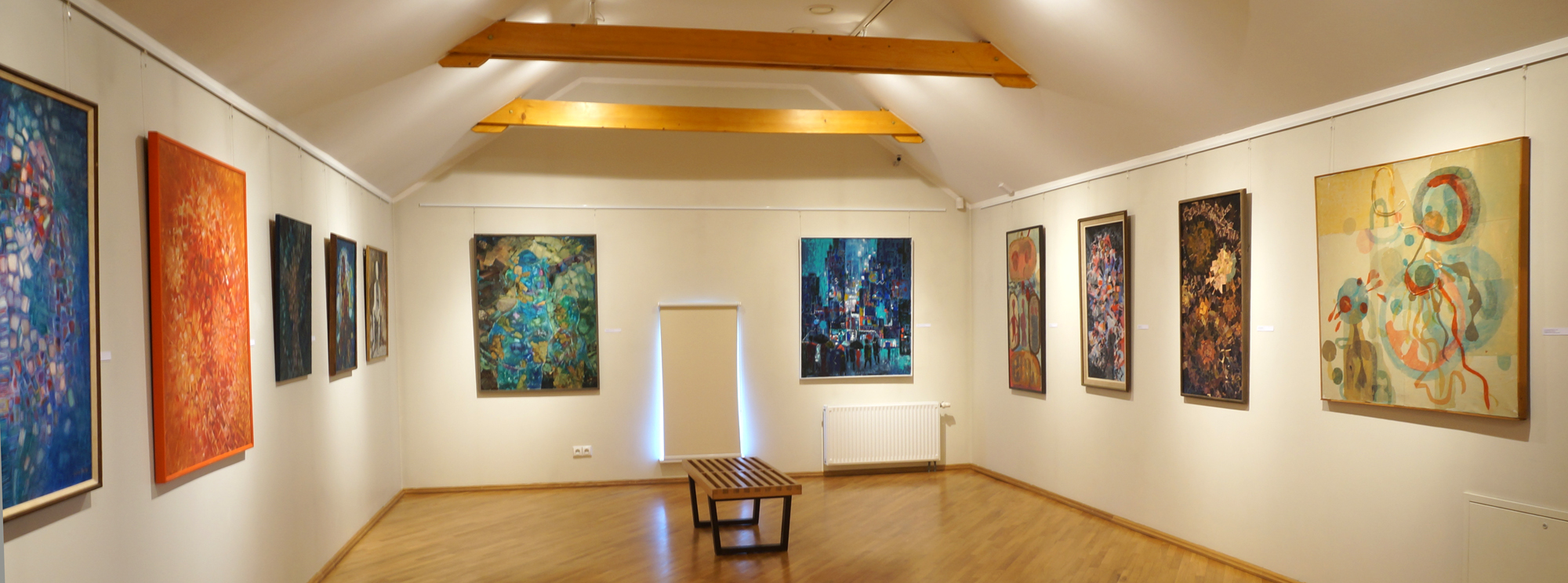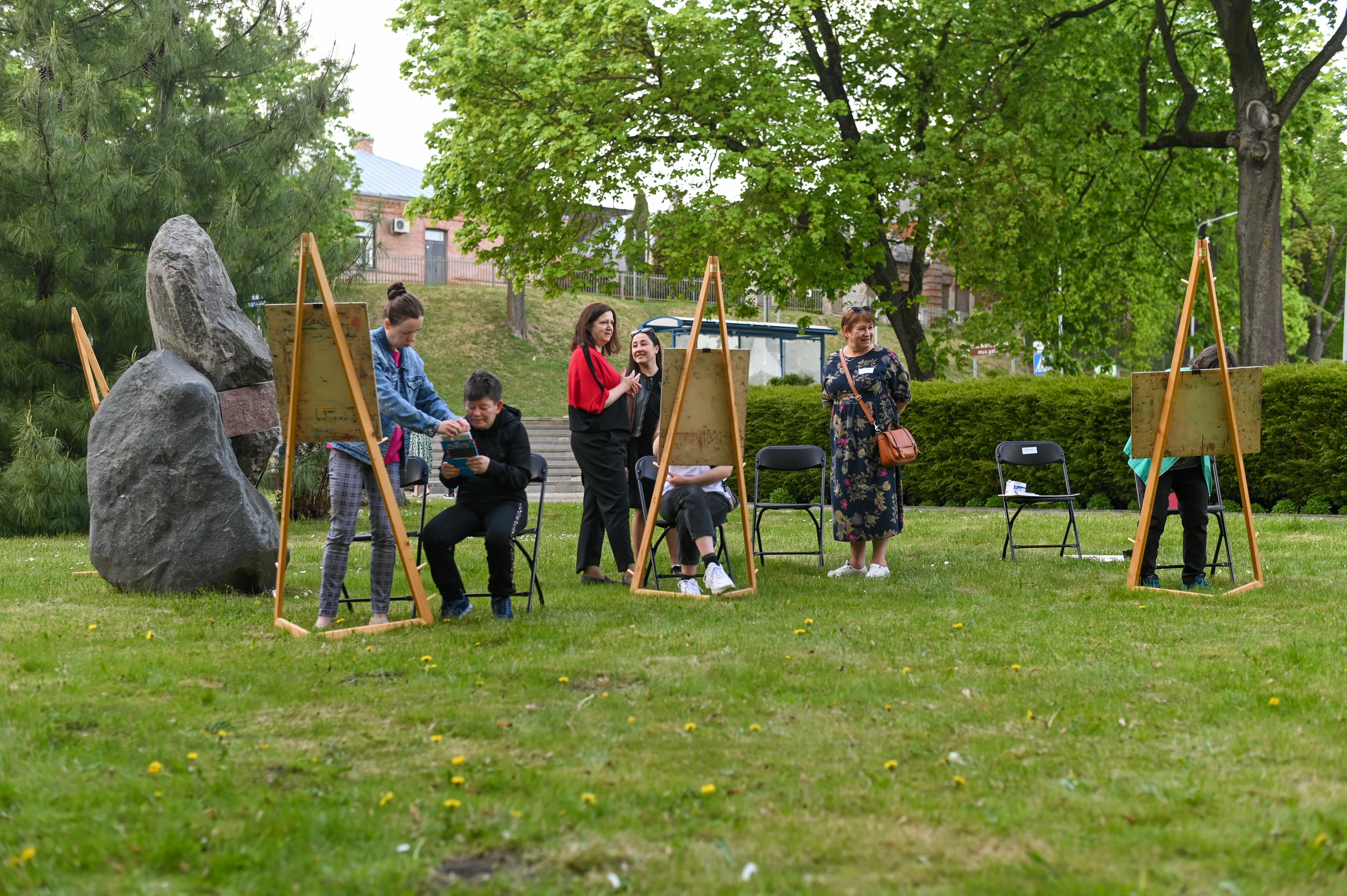The Museum opened its doors to the public on October 20, 2001. American Ambassador John Tefft and his wife Mariella, Kedainiai Regional Mayor Victoras Muntianas and many honorable quests from Vilnius and Kaunas participated at the opening ceremony. In 2000, Janina Monkute-Marks established a Not For Profit Institution in Kedainiai.
The Museum gallery was reconstructed using a single floor two-wing building – which from the early twentieth century till the First World War was a building of Juozapava Homestead – as a basis. During the interwar period the reconstructed building was a notary office; in the first decades of the Soviet period – a home for students, and from 1967 to 2000 – Kedainiai Regional Museum.
August 12, 2007 Janina Monkute-Marks was presented with the title of Kedainiai’s Honorary Citizen. This title was bestowed upon her for her outstanding dedication and constant cultural input into the district of Kedainiai. She is also recognized for introducing foreign artists to Lithuania, as well as for continuing education through art and promoting Lithuanian culture around the world.
About Janina Monkute – Marks
Janina Monkute-Marks was born in Radviliškis, Lithuania on September 21st 1923, and passed away on November 13th, 2010 .
She studied in Pagegiai Primary and Secondary School. In 1939-1941 continuing her studies at the High School, in Kėdainiai. In 1941 Janina entered the drama studio in Kaunas Drama Theatre. While studying there she graduated from The Fifth High School in Kaunas.
In the autumn of 1944, because of the war, Janina relocated to Germany. From 1945 to 1947, she studied archaeology, art history and Romans languages at Innsbruck University (Austria).
In 1947-1950 attended École des Arts et Métiers in Freiburg (Germany). There she acquired her skills in the visual arts: studied textile with professor Antanas & Mrs. Anastazija Tamošaitis, drawing – with Vytautas Kasiulis and Vytautas Kazimieras Jonynas, graphics – with Viktoras Petravičius.
In 1950 Janina emigrated to the USA. After 1956 she actively practiced as an artist in Chicago, studied and worked with many artists, such as Don Baum, Claude Bentley, Harry Bouros, Harold Haydon and Viktoras Petravičius. She was closely associated with the Hyde Park Art Center and B.I.G. Arts Center in Sanibel Island (Florida). Since 1972 Janina Marks started organizing the popular “Annual Members Exhibition” in Hyde Park Art Center in Chicago. In 1974 the artist was one of the founders and leaders of the Lithuanian Woman Artists Association in Chicago.
Her works were exhibited in the Chicago Art Institute, The North Shore Art League (Winnetka, Illinois), Dunes Art Foundation (Michigan City, Indiana), Sun Times Gallery (Chicago, Illinois), Old Water Tower Place (Chicago, Illinois) etc. She had more than twenty one-person shows. Janina Marks constantly took part in the exhibitions of the Lithuanian Art Centers, such as Balzekas Museum of Lithuanian Culture, Čiurlionis Gallery, and Lithuanian Art Museum in Lemont.
As art critic Danas Lapkus admitted, “Janina Monkute- Marks attained an important place in Lithuanian and American art, especially for her work in the field of textiles. Recurrent invitations to participate in juried American and international exhibits are proof of her artistic success. But one needs only to look at the paintings, prints, and textiles where the ironic and the tragic, the religious and the liberal, primitive and modern are elegantly combined to really appreciate the importance of Janina Monkute-Marks’ art“.
The most important collection of Janina Monkute-Marks museum gallery:
The early art of Janina Monkute-Marks (1958-1962)
Though indirectly, her early paintings reflect the drama of World War II and emigration. Her paintings of 1958-1960 are dominated by dramatic tension and a sense of the unknown. The artist was encouraged to share her painful story by the popular Chicago group Art Brute. The group’s most successful members, Leon Golub and Seymour Rossofsky, were famous for depicting themes of war, aggression, violence, and estrangement. In this context, Janina Monkute-Marks’ painting entitled Tunnel, featuring one of the underground street crossings in Chicago, becomes a metaphor of loneliness, limited opportunities, an uncertain future, and an attempt to break free.
In the early 1960’s, Janina Monkute-Marks’ painting turns toward abstraction and decorativeness. The artist starts experimenting with collage and gesso priming. <…> The titles of this period’s paintings, such as It’s Hard to Find a Way, Night Shadows and Tired Football Player, impart a sense of melancholy. The view is intentionally flat – the artist is portraying emotion, not a three-dimensional imitation of reality. The glittering mosaic-like multicoloured squares convey constantly changing surroundings and frames of mind.

Pop Art series in the art of Janina Monkute-Marks (1962-1966)
Janina Monkute-Marks continues to compare the banal and the essential in her Pop series of 1962-1966. At the time, Pop Art was a contemporary phenomenon still searching for a developmental path. The famous Pop artists Andy Warhol, Roy Lichtenstein, and Robert Rauchenberg instituted the depiction and critique of consumer society as the main theme. They focused on advertisements, cartoons, commercially exploited national symbols, and TV reality and elevated them to the status of the artistically important subject. Like the Pop Art masters, Janina Monkute-Marks used large formats, intense and bright colors (often, commercial paint), text, and collage.

Folk Art symbols in the paintings of Janina Monkute-Marks (1960-1970)
The artist’s interest in Lithuanian folklore and her collection of ethnographic art have naturally led her to folk art as a source of universal wisdom. Janina Monkutė-Marks: „I began to explore my roots, Lithuanian folklore, folk songs, and folk art. My oil paintings based upon mythology are especially colorful and poster-like. I enjoyed using rich colors and interpreting playful themes. So much wealth can be found in folk mythology!“.
Many of these “folk art” paintings are reminiscent of the mandala, the visual symbol of the universe created by Hindus and Buddhists. As in traditional mandalas, the artist divides a circle into four parts. Instead of placing a square inside the circle, she frames the circle with the square. Deities, mythological beings, and ornamentations flank each of the circle’s four projections. Even the recognizable figures acquire the quality of an ornament because of the endless rhythm of circular repetition.

Prints of Janina Monkute-Marks
“Some of the artist’s prints imitate the compositional scheme of traditional folk art (“My Road”, “Angel”), but much more significant is the influence on Janina Monkute-Marks of one of her teachers, Viktoras Petravicius. Like Petravicius’ prints, which are considered classics of Lithuanian art, her linoleum block prints combine the rough shaping of individual forms geometric ornaments – are substantial and generalized, represented not only by a contour line but also by entire silhouette. The artist fully employs the deep contrast and intensity characteristic of linoleum block printing. Black and white spaces seem intertwined and equally important in Janina Monkute-Marks’ prints on rice paper. This black-and-white rhythm takes over the story and creates the effect of an ornament in such prints as In “The Backwoods” and “Birds of Paradise”.
Some of Janina Monkute-Marks’ most beautiful prints include symbols, which laconically suggest pre-Christian wisdom. These symbols unite floral anthropomorphic allusions, geometric abstractions, traditional ornaments and the artist’s original motifs into a mysterious magical world. Equally impressive are the large artist’s proofs, such as “Man and Woman” and “Jamaica Revisited”, produced from several blocks of linoleum. The large size reveals the outstanding compositional skills and sensitive printing technique (she often uses a simple table-spoon) of the artist. The artist’s proofs are hand-painted in watercolor. The combination of solid black lines and silhouettes together with bright, warm colors results in a stained glass like effect.”

Tapestries and rugs by Janina Monkute-Marks (1970-2010)
Numerous art critics have suggested that many of Janina Marks’ paintings and prints would make excellent designs for tapestries. The artist has also admitted an ever-present inclination to return to weaving, her favorite subject in Freiburg. Janina Monkutė-Marks: „I wanted to touch the textures of thread; ornament and color no longer satisfied me. The very process of weaving enchanted me. It is a very exacting and time-consuming task, but I felt it suited me well. I am happy to be able to express joy and pain and a part of myself in weaving. To me, weaving has become a language that I use to tell stories of the sea, land, sunrise, everyday life, and dreams“.
The motif of road and journey is one of the most significant in the art of Janina Marks. Journey is interpreted as a quest for the meaning of life and soul-searching in the tapestries Man and His World, Longing for Freedom, Going Home, and My Road.

FOLLOW US ON FACEBOOK
FOLLOW US ON INSTAGRAM





































